This is an old revision of this page, as edited by KingSkyLord (talk | contribs) at 01:21, 11 April 2017 (added (Spanish) to the Spanish name of the Republic of Texas). The present address (URL) is a permanent link to this revision, which may differ significantly from the current revision.
Revision as of 01:21, 11 April 2017 by KingSkyLord (talk | contribs) (added (Spanish) to the Spanish name of the Republic of Texas)(diff) ← Previous revision | Latest revision (diff) | Newer revision → (diff)
| Republic of Texas República de Tejas (Spanish) | |||||||||||||||||||||||
|---|---|---|---|---|---|---|---|---|---|---|---|---|---|---|---|---|---|---|---|---|---|---|---|
| 1836–1846 | |||||||||||||||||||||||
 Flag
Flag(1836–39)  Seal
Seal(1836-39) | |||||||||||||||||||||||
 Map of the Republic of Texas in green. The claimed area is in light green, while populated territory is in dark green. Map of the Republic of Texas in green. The claimed area is in light green, while populated territory is in dark green. | |||||||||||||||||||||||
| Capital | San Antonio de Bexar (Mexican Texas) San Felipe de Austin (1835, provisional) Washington-on-the-Brazos (1836, interim) Harrisburg (1836, interim) Galveston (1836, interim) Velasco (1836, interim) Columbia (1836–37) Houston (1837–39) Austin (1839–46) | ||||||||||||||||||||||
| Common languages | English and Spanish (de facto)
French, German Native languages (Caddo, Comanche) and Czech regionally | ||||||||||||||||||||||
| Government | Constitutional republic | ||||||||||||||||||||||
| President | |||||||||||||||||||||||
| • 1836 | David G. Burnet | ||||||||||||||||||||||
| • 1836–38 | Sam Houston | ||||||||||||||||||||||
| • 1838–41 | Mirabeau B. Lamar | ||||||||||||||||||||||
| • 1841–44 | Sam Houston | ||||||||||||||||||||||
| • 1844–46 | Anson Jones | ||||||||||||||||||||||
| Vice President | |||||||||||||||||||||||
| • 1836 | Lorenzo de Zavala | ||||||||||||||||||||||
| • 1836–38 | Mirabeau B. Lamar | ||||||||||||||||||||||
| • 1838–41 | David G. Burnet | ||||||||||||||||||||||
| • 1841–44 | Edward Burleson | ||||||||||||||||||||||
| • 1844–45 | Kenneth L. Anderson | ||||||||||||||||||||||
| Legislature | Congress | ||||||||||||||||||||||
| Historical era | Western Expansion | ||||||||||||||||||||||
| • Independence from Mexico | March 2 1836 | ||||||||||||||||||||||
| • Annexation by the United States of America | December 29, 1845 | ||||||||||||||||||||||
| • Transfer of power | February 19 1846 | ||||||||||||||||||||||
| Area | |||||||||||||||||||||||
| 1840 | 1,007,935 km (389,166 sq mi) | ||||||||||||||||||||||
| Population | |||||||||||||||||||||||
| • 1840 | 70,000 | ||||||||||||||||||||||
| Currency | Republic of Texas Dollar | ||||||||||||||||||||||
| |||||||||||||||||||||||
| Today part of | |||||||||||||||||||||||
| Interim period (March 16 – October 22, 1836): President: David G. Burnet, Vice President Lorenzo de Zavala | |||||||||||||||||||||||
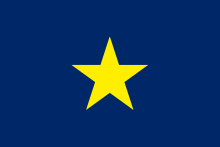

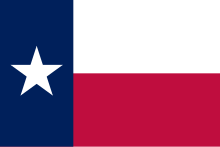
The Republic of Texas (Spanish: República de Tejas) was an independent sovereign country in North America that existed from March 2, 1836, to February 19, 1846. It was bordered by Mexico to the west and southwest, the Gulf of Mexico to the southeast, the two U.S. states of Louisiana and Arkansas to the east and northeast, and United States territories encompassing parts of the current U.S. states of Oklahoma, Kansas, Colorado, and Wyoming to the north. The citizens of the republic were known as Texians.
The Mexican province of Tejas (in English history books usually referred to as Mexican Texas) declared its independence from Mexico during the Texas Revolution in 1836. The Texas war of independence ended on April 21, 1836, but Mexico refused to recognize the independence of the Republic of Texas, and intermittent conflicts between the two states continued into the 1840s. The United States recognized the Republic of Texas in March 1837 but declined to annex the territory.
The Republic-claimed borders were based upon the Treaties of Velasco between the newly created Texas Republic and Antonio López de Santa Anna of Mexico. The eastern boundary had been defined by the Adams–Onís Treaty of 1819 between the United States and Spain, which recognised the Sabine River as the eastern boundary of Spanish Texas and western boundary of the Missouri Territory. Under the Adams–Onís Treaty of 1819 the United States had renounced its claim to Spanish land to the east of the Rocky Mountains and to the north of the Rio Grande which it claimed to have acquired as part of the Louisiana Purchase of 1803.
The republic's southern and western boundary with Mexico continued to be disputed throughout the republic's existence. Texas claimed the Rio Grande as its southern boundary, while Mexico insisted that the Nueces River was the boundary. Texas was annexed by the United States on December 29, 1845 and was admitted to the Union as the 28th state on that day, with the transfer of power from the Republic to the new state formally taking place on February 19, 1846. However, the United States again inherited the southern and western border dispute with Mexico, which became a trigger for the Mexican–American War of 1846–48.
History
Texas prior to independence
See also: Spanish Texas and Mexican TexasTexas had been one of the Provincias Internas of New Spain, a region known historiographically as Spanish Texas. Though claimed by Spain, it was not formally colonized by them until competing French interests at Fort St. Louis encouraged Spain to establish permanent settlements in the area. Sporadic missionary incursions occurred into the area during the period from the 1690s–1710s, before the establishment of San Antonio as a permanent civilian settlement. Owing to the area's high Native American populations and its remoteness from the population centers of New Spain, Texas remained largely unsettled by Europeans, although Spain maintained a small military presence to protect Christian missionaries working among Native American tribes, and to act as a buffer against the French in Louisiana and British North America. In 1762, France ceded to Spain most of its claims to the interior of North America, including its claim to Texas, as well as the vast interior that became Spanish Louisiana. During the years 1799 to 1803, the height of the Napoleonic Empire, Spain returned Louisiana back to France, which promptly sold the territory to the United States. The status of Texas during these transfers was unclear and was not resolved until 1819, when the Adams–Onís Treaty ceded Spanish Florida to the United States, and established a clear boundary between Texas and Louisiana.
Starting in 1810, the territories of New Spain north of the Isthmus of Panama (including Texas) sought independence in the Mexican War of Independence. Many Americans fought on the side of Mexico against Spain in filibustering expeditions. One of these, the Gutiérrez–Magee Expedition (also known as the Republican Army of the North) consisted of a group of about 130 Americans under the leadership of Bernardo Gutiérrez de Lara. Gutierrez de Lara initiated Mexico's secession from Spain with efforts contributed by Magee. Bolstered by new recruits, and led Samuel Kemper (who succeeded Magee after his death in battle in 1813), the expedition gained a series of victories against soldiers led by the Spanish governor, Manuel María de Salcedo. Their victory at the Battle of Rosillo Creek convinced Salcedo to surrender on April 1, 1813; he was executed two days later. On April 6, 1813, the victorious Republican Army of the North drafted a constitution and declared the independent Republic of Texas, with Gutiérrez as its president. Soon disillusioned with the Mexican leadership, the Americans under Kemper returned to the United States. The ephemeral Republic of Texas came to an end following the August 18, 1813 Battle of Medina, where the Spanish Army crushed the Republican Army of the North. The harsh reprisals against the Texas rebels created a deep distrust of the Royal Spanish authorities, and veterans of the Battle of Medina would later become leaders of the Texas Revolution and signatories of the Texas Declaration of Independence from Mexico some 20 years later.
Along with the rest of Mexico, Texas gained its independence from Spain following the Treaty of Córdoba, and the new Mexican state was organized under the Plan of Iguala which created Mexico as a constitutional monarchy under its first Emperor Agustín de Iturbide. During the transition from a Spanish territory to part of the independent country of Mexico, Stephen F. Austin led a group of American settlers known as the Old Three Hundred, who negotiated the right to settle in Texas with the Spanish Royal governor of the territory. Since Mexican independence had been ratified by Spain shortly thereafter, Austin would later travel to Mexico City to secure the support of the new country in his right to settle. The establishment of Mexican Texas coincided with the Austin-led settlement, leading to animosity between Mexican authorities and ongoing American settlement of Texas. The First Mexican Empire was short lived, being replaced by a republican form of government in 1823. Following Austin's lead, additional groups of settlers, known as Empresarios, continued to colonize Mexican Texas from the United States. In 1830, Mexican President Anastasio Bustamante outlawed American immigration to Texas, following several conflicts with the Empresarios over the status of slavery in the region. Angered at the interference of the Mexican government, the Empresarios held the Convention of 1832, which is considered the first formal step in what would later become the Texas Revolution.
On the eve of war, the American settlers in the area outnumbered Mexicans by a considerable margin. Following a series of minor skirmishes between Mexican authorities and the settlers, the Mexican government, fearing open rebellion of their Anglo subjects, began to step up military presence in Texas throughout 1834 and early 1835. Mexican President Antonio López de Santa Anna revoked the 1824 Constitution of Mexico and began to consolidate power in the central government under his own leadership. The Texian leadership under Austin began to organize its own military, and hostilities broke out on October 2, 1835 at the Battle of Gonzales, the first engagement of the Texas Revolution. In November, 1835 a provisional government known as the Consultation was established to oppose the Santa Anna regime (but stopped short of declaring independence from Mexico). On March 1, 1836 the Convention of 1836 came to order, and the next day declared independence from Mexico, establishing the Republic of Texas.
Independent republic

Politics
The second Congress of the Republic of Texas convened in October 1836 at Columbia (now West Columbia). Stephen F. Austin, known as the Father of Texas, died December 27, 1836, after serving two months as Secretary of State for the new Republic.
In 1836, five sites served as temporary capitals of Texas (Washington-on-the-Brazos, Harrisburg, Galveston, Velasco and Columbia), before President Sam Houston moved the capital to Houston in 1837. The next president, Mirabeau B. Lamar, moved the capital to the new town of Austin in 1839.
The first flag of the republic was the "Burnet Flag" (a gold star on an azure field), followed in 1839 by official adoption of the Lone Star Flag.
Internal politics of the Republic centred on two factions. The nationalist faction, led by Lamar, advocated the continued independence of Texas, the expulsion of the Native Americans (Indians), and the expansion of Texas to the Pacific Ocean. Their opponents, led by Houston, advocated the annexation of Texas to the United States and peaceful coexistence with the Indians, when possible. The Texas Congress even passed a resolution over Houston's veto claiming the Californias for Texas. The 1844 presidential election split the electorate dramatically, with the newer western regions of the Republic preferring the nationalist candidate Edward Burleson, while the cotton country, particularly east of the Trinity River, went for Anson Jones.
Armed conflict
The Comanche Indians furnished the main Indian opposition to the Texas Republic, manifested in multiple raids on settlements, capture and rape of female pioneers, torture killings, and trafficking in captive slaves. In the late 1830s, Sam Houston negotiated a peace between Texas and the Comanches. Lamar replaced Houston as president in 1838 and reversed the Indian policies. He returned to war with the Comanches and invaded Comancheria itself. In retaliation, the Comanches attacked Texas in a series of raids. After peace talks in 1840 ended with the massacre of 34 Comanche leaders in San Antonio, the Comanches launched a major attack deep into Texas, known as the Great Raid of 1840. Under command of Potsanaquahip (Buffalo Hump), 500 to 700 Comanche cavalry warriors swept down the Guadalupe River valley, killing and plundering all the way to the shore of the Gulf of Mexico, where they sacked the towns of Victoria and Linnville. Houston became president again in 1841 and, with both Texians and Comanches exhausted by war, a new peace was established.
Although Texas achieved self-government, Mexico refused to recognize its independence. On March 5, 1842, a Mexican force of over 500 men, led by Ráfael Vásquez, invaded Texas for the first time since the revolution. They soon headed back to the Rio Grande after briefly occupying San Antonio. About 1,400 Mexican troops, led by the French mercenary general Adrián Woll, launched a second attack and captured San Antonio on September 11, 1842. A Texas militia retaliated at the Battle of Salado Creek while simultaneously, a mile and a half away, Mexican soldiers massacred a militia of fifty-three Texas volunteers who had surrendered after a skirmish. That night, the Mexican Army retreated from the city of San Antonio back to Mexico.
Mexico's attacks on Texas intensified conflicts between political factions, including an incident known as the Texas Archive War. To "protect" the Texas national archives, President Sam Houston ordered them removed from Austin. The archives were eventually returned to Austin, albeit at gunpoint. The Texas Congress admonished Houston for the incident, and this episode in Texas history would solidify Austin as Texas's seat of government for the Republic and the future state.
There were also domestic disturbances. The Regulator–Moderator War involved a land feud in Harrison and Shelby Counties in East Texas from 1839 to 1844. The feud eventually involved Nacogdoches, San Augustine, and other East Texas counties. Harrison County Sheriff John J. Kennedy and county judge Joseph U. Fields helped end the conflict, siding with the law-and-order party. Sam Houston ordered 500 militia to help end the feud.
Government

After gaining their independence, the Texas voters had elected a Congress of 14 senators and 29 representatives in September 1836. The Constitution allowed the first president to serve for two years and subsequent presidents for 3 years. In order to hold an office or vote, a person needed to be a citizen of the Republic.
However, it is important to note that citizenship was not granted to all previous inhabitants of Texas, and not all of them could even live legally within the limits of the Republic without the consent of Congress. In this regard, the Constitution of the Republic of Texas (1836) established major differences according to the ethnicity of each individual. Section 10 of the General Provisions of the constitution stated that all persons who were residing in Texas on the day of the Declaration of Independence were to be considered citizens of the Republic, excepting "Africans, the descendants of Africans, and Indians". For new white immigrants, section 6 established that, in order to become citizens, they needed to live in the Republic for at least six months and take an oath. While regarding the black population, section 9 established that black persons who were brought to Texas as slaves were to remain slaves, and that not even their owner could emancipate them without the consent of Congress, while the Congress itself was not allowed to make laws affecting the slave trade or to declare emancipation. Section 9 also established that: "No free person of African descent, either in whole or in part, shall be permitted to reside permanently in the Republic, without the consent of Congress".
The first Congress of the Republic of Texas convened in October 1836 at Columbia (now West Columbia). Stephen F. Austin, often referred to as the "Father of Texas," died on December 27, 1836, after serving just two months as the republic's secretary of state. Due mainly to the ongoing war for independence, five sites served as temporary capitals of Texas in 1836: (Washington-on-the-Brazos, Harrisburg, Galveston, Velasco and Columbia). The capital was moved to the new city of Houston in 1837.
In 1839, a small pioneer settlement situated on the Colorado River in central Texas was chosen as the republic's seventh and final capital. Incorporated under the name Waterloo, the town was renamed Austin shortly thereafter in honor of Stephen F. Austin.
The court system inaugurated by Congress included a Supreme Court consisting of a chief justice appointed by the president and four associate justices, elected by a joint ballot of both houses of Congress for four-year terms and eligible for re-election. The associates also presided over four judicial districts. Houston nominated James Collinsworth to be the first chief justice. The county-court system consisted of a chief justice and two associates, chosen by a majority of the justices of the peace in the county. Each county was also to have a sheriff, a coroner, justices of the peace, and constables to serve two-year terms. Congress formed 23 counties, whose boundaries generally coincided with the existing municipalities.
In 1839, Texas became the first nation in the world to enact a homestead exemption under which a person's primary residence could not be seized by creditors.
Boundaries

The Texan leaders at first intended to extend their national boundaries to the Pacific Ocean, but ultimately decided to claim the Rio Grande as boundary, including much of New Mexico, which the Republic never controlled. They also hoped, after peace was made with Mexico, to run a railroad to the Gulf of California to give "access to the East Indian, Peruvian and Chilean trade." When negotiating for the possibility of annexation to the US in late 1836, the Texan government instructed its minister Wharton in Washington that if the boundary were an issue, Texas was willing to settle for a boundary at the watershed between the Nueces River and Rio Grande, and leave out New Mexico. In 1840 the first and only census of the Republic of Texas was taken, recording a population of about 70,000 people. San Antonio and Houston were recorded as the largest and second largest cities respectively.
Diplomatic relations
Main article: Foreign relations of the Republic of Texas
On March 3, 1837, US President Andrew Jackson appointed Alcée La Branche American chargé d'affaires to the Republic of Texas, thus officially recognizing Texas as an independent republic. France granted official recognition of Texas on September 25, 1839, appointing Alphonse Dubois de Saligny to serve as chargé d'affaires. The French Legation was built in 1841, and still stands in Austin as the oldest frame structure in the city. Conversely, the Republic of Texas embassy in Paris was located in what is now the Hôtel de Vendôme, adjacent to the Place Vendôme in Paris' 2e arrondissement.
The Republic also received diplomatic recognition from Belgium, the Netherlands, and the Republic of Yucatán. The United Kingdom never granted official recognition of Texas due to its own friendly relations with Mexico, but admitted Texan goods into British ports on their own terms. In London, the original Embassy of the Republic of Texas still stands, and there is a restaurant with such a name west of Trafalgar Square. Immediately opposite the gates to St. James's Palace, Sam Houston's original Embassy of the Republic of Texas to the Court of St. James's is now a hat shop, but is clearly marked with a large plaque and a nearby restaurant is called Texas Embassy. A plaque on the exterior of 3 St. James's Street in London notes the upper floors of the building (which have housed the noted wine merchant Berry Brothers and Rudd since 1698) housed the Texas Legation.
Presidents and vice presidents
Main article: President of the Republic of Texas| Presidents and Vice Presidents of the Republic of Texas | |||||||
|---|---|---|---|---|---|---|---|
| № | Portrait | President | Term of Office | Party | Term | Previous Office | Vice President |
| — | 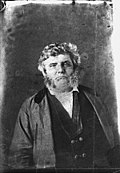
|
David G. Burnet (1788-04-18)April 18, 1788 - (1870-12-05)December 5, 1870 (aged 82) |
March 16, 1836 – October 22, 1836 |
Nonpartisan | Interim |
Delegate to the Convention of 1833 |
Lorenzo de Zavala |
| 1 | 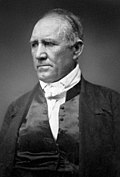
|
Sam Houston (1793-03-02)March 2, 1793 - (1863-07-26)July 26, 1863 (aged 70) |
October 22, 1836 – December 10, 1838 |
Nonpartisan | 1 (1836) |
Commander-in-Chief of the Texian Army (1836) |
Mirabeau B. Lamar |
| 2 | 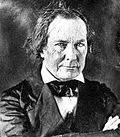
|
Mirabeau B. Lamar (1798-08-16)August 16, 1798 - (1859-12-19)December 19, 1859 (aged 61) |
December 10, 1838 – December 13, 1841 |
Nonpartisan | 2 (1838) |
1st Vice President of the Republic of Texas (1836-1838) |
David G. Burnet |
| 3 | 
|
Sam Houston (1793-03-02)March 2, 1793 - (1863-07-26)July 26, 1863 (aged 70) |
December 13, 1841 – December 9, 1844 |
Nonpartisan | 3 (1841) |
1st President of the Republic of Texas (1836-1838) |
Edward Burleson |
| 4 | 
|
Anson Jones (1798-01-20)January 20, 1798 - (1858-01-09)January 9, 1858 (aged 59) |
December 9, 1844 – February 19, 1846 |
Nonpartisan | 4 (1844) |
11th Secretary of State of the Republic of Texas (1841-1844) |
Kenneth Anderson December 9, 1844 - July 3, 1845 |
Statehood
Main article: Texas annexationOn February 28, 1845, the US Congress passed a bill that would authorize the United States to annex the Republic of Texas. On March 1, US President John Tyler signed the bill. The legislation set the date for annexation for December 29 of the same year. Faced with imminent American annexation of Texas, Charles Elliot and Alphonse de Saligny, the British and French ministers to Texas, were dispatched to Mexico City by their governments. Meeting with Mexico's foreign secretary, they signed a "Diplomatic Act" in which Mexico offered to recognize an independent Texas with boundaries that would be determined with French and British mediation. Texas President Anson Jones forwarded both offers to a specially elected convention meeting at Austin, and the American proposal was accepted with only one dissenting vote. The Mexican proposal was never put to a vote. Following the previous decree of President Jones, the proposal was then put to a vote throughout the republic.


On October 13, 1845, a large majority of voters in the republic approved both the American offer and the proposed constitution that specifically endorsed slavery and emigrants bringing slaves to Texas. This constitution was later accepted by the US Congress, making Texas a US state on the same day annexation took effect, December 29, 1845 (therefore bypassing a territorial phase). One of the motivations for annexation was the huge debts which the Republic of Texas government had incurred. As part of the Compromise of 1850, in return for $10,000,000 in Federal bonds, Texas dropped claims to territory which included parts of present-day Colorado, Kansas, Oklahoma, New Mexico, and Wyoming.
The resolution did include two unique provisions: First, it said up to four additional states could be created from Texas' territory with the consent of the State of Texas (and that new states north of the Missouri Compromise Line would be free states). Though the resolution did not make exceptions to the constitution, the U.S. Constitution neither requires Congressional consent to the creation of new states to be ex post to applications nor to expire. To illustrate the strength of the latter caveat, the 27th Amendment was submitted to the states in 1789, yet was not ratified until 1992; thus, the expressed consent of Congress, via this resolution, to the creation of new states would not expire nor require renewal. Second, Texas did not have to surrender its public lands to the federal government. While Texas did cede all territory outside of its current area to the federal government in 1850, it did not cede any public lands within its current boundaries. Consequently, the lands in Texas owned by the federal government are those which were subsequently purchased by it. This also means the state government has control over oil reserves which were later used to fund the state's public university system through the Permanent University Fund. In addition, the state's control over offshore oil reserves in Texas runs out to 3 nautical leagues (9 nautical miles, 10.357 statute miles, 16.668 km) rather than three nautical miles (3.45 statute miles, 5.56 km) as with other states.
See also
- California Republic
- Timeline of the Republic of Texas
- The Texas Legation
- History of slavery in Texas
Notes
- ^ "Flags of Texas". Handbook of Texas Online. Texas State Historical Association. Retrieved June 3, 2016.
- Henderson (2008), p. 121.
- Weber, David J. (1992), The Spanish Frontier in North America, Yale Western Americana Series, New Haven, Connecticut: Yale University Press, p. 149, ISBN 0-300-05198-0
- Chipman, Donald E. (2010) , Spanish Texas, 1519–1821 (revised ed.), Austin: University of Texas Press, p. 126, ISBN 0-292-77659-4
- Weber (1992), p. 198.
- Lewis, James E. (1998), The American Union and the Problem of Neighborhood: The United States and the Collapse of the Spanish Empire, 1783–1829, Chapel Hill: University of North Carolina Press, p. 124, ISBN 0-8078-2429-1
- Weber (1992), p. 299.
- Edmondson, J.R. (2000). The Alamo Story-From History to Current Conflicts. Plano, TX: Republic of Texas Press. p. 63. ISBN 1-55622-678-0.
- Manchaca, Martha (2001). Recovering History, Constructing Race: The Indian, Black, and White Roots of Mexican Americans. The Joe R. and Teresa Lozano Long Series in Latin American and Latino Art and Culture. Austin, TX: University of Texas Press. p. 200. ISBN 0-292-75253-9.
- Manchaca (2001), pp. 172, 201.
- Hardin, Stephen L. (1994). Texian Iliad. Austin, TX: University of Texas Press. p. 12. ISBN 0-292-73086-1.
- Lack, Paul D. (1992). The Texas Revolutionary Experience: A Political and Social History 1835–1836. College Station, TX: Texas A&M University Press. pp. 86–87. ISBN 0-89096-497-1.
- #Fehrenbach, page 263
- #Fehrenbach, page 265
- This had also been their policy toward neighboring tribes before the arrival of the settlers. Gwinnett, S.C. Empire of the Summer Moon: Quanah Parker and the Rise and Fall of the Comanches, the Most Powerful Indian Tribe in American History. ISBN 1-4165-9106-0.
- Hämäläinen 2008, pp. 215–217.
- Jack W. Gunn, "MEXICAN INVASIONS OF 1842," Handbook of Texas Online , accessed May 24, 2011. Published by the Texas State Historical Association.
- Thomas W. Cutrer, "SALADO CREEK, BATTLE OF," Handbook of Texas Online <http://www.tshaonline.org/handbook/online/articles/qfs01>, accessed May 24, 2011. Published by the Texas State Historical Association.
- "Dawson Massacre". Handbook of Texas Online. Retrieved Sep.24, 2006.
- "The Archives War". Texas Treasures – The Republic. The Texas State Library and Archives Commission. November 2, 2005. Retrieved January 3, 2009.
- Davis, William C. (2006). Lone Star Rising. College Station, TX: Texas A&M University Press. p. 295. ISBN 978-1-58544-532-5. originally published 2004 by New York: Free Press
- "General Provisions - Constitution of the Republic of Texas (1836)". tarlton.law.utexas.edu. Retrieved February 26, 2016.
- "General Provisions - Constitution of the Republic of Texas (1836)". tarlton.law.utexas.edu. Retrieved February 26, 2016.
- George Rives, The United States and Mexico vol. 1, page 390
- Rives, p. 403
- "LA BRANCHE, ALCÉE LOUIS". Handbook of Texas Online. Retrieved Apr.7, 2010.
- Museum Info, French Legation Museum.
- "PARIS 2e: The Paris Embassy of Texas". Parisdeuxieme.com. June 28, 2007. Retrieved July 10, 2013.
- "DIPLOMATIC RELATIONS OF THE REPUBLIC OF TEXAS".
- "Article VIII: Slaves - Constitution of Texas (1845) (Joining the U.S.)".
- "The Avalon Project : Documents in Law, History and Diplomacy".
- "Joint Resolution for Annexing Texas to the United States Approved March 1, 1845 - TSLAC".
- Texas Annexation : Questions and Answers, Texas State Library & Archives Commission.
- Overview of US Legislation and Regulations Affecting Offshore Natural Gas and Oil Activity
- "United States v. Louisiana :: 363 U.S. 1 (1960) :: Justia U.S. Supreme Court Center". Justia Law.
References
| Part of a series on the | ||||||||||||||||||
|---|---|---|---|---|---|---|---|---|---|---|---|---|---|---|---|---|---|---|
| History of Texas | ||||||||||||||||||
 | ||||||||||||||||||
| Timeline | ||||||||||||||||||
|
||||||||||||||||||
|
| ||||||||||||||||||
- Huson, Hobart (1974), Captain Phillip Dimmitt's Commandancy of Goliad, 1835–1836: An Episode of the Mexican Federalist War in Texas, Usually Referred to as the Texan Revolution, Austin, TX: Von Boeckmann-Jones Co
- Hämäläinen, Pekka (2008), The Comanche Empire, Yale University Press, ISBN 978-0-300-12654-9
- Lack, Paul D. (1992), The Texas Revolutionary Experience: A Political and Social History 1835–1836, Texas A&M University Press, ISBN 0-89096-497-1
- Fehrenbach, T. R. (2000), Lone Star: a history of Texas and the Texans, Da Capo Press, ISBN 978-0-306-80942-2
- Republic of Texas Historical Resources
- Republic of Texas from the Handbook of Texas Online
- Hosted by Portal to Texas History:
- Texas: the Rise, Progress, and Prospects of the Republic of Texas, Vol. 1, by William Kennedy, published 1841
- Texas: the Rise, Progress, and Prospects of the Republic of Texas, Vol. 2, published 1841
- Laws of the Republic, 1836–1838 from Gammel's Laws of Texas, Vol. I.
- Laws of the Republic, 1838–1845 from Gammel's Laws of Texas, Vol. II.
- The Avalon Project at Yale Law School: Texas – From Independence to Annexation
- Early Settlers and Indian Fighters of Southwest Texas by Andrew Jackson Sowell 1900
Further reading
- Hardin, Stephen L.; Wade, Mary Dodson (1998). Lone Star: The Republic of Texas, 1836–1846. Discovery Enterprises. ISBN 978-1-878668-63-9.
- Hogan, William Ransom (2007). The Texas Republic: A Social and Economic History. Texas State Historical Association. ISBN 978-0-87611-220-5.
- Lankevich, George J. (1979). The Presidents of the Republic of Texas: Chronology, Documents, Bibliography. Oceana Publications. ISBN 978-0-379-12085-1.
- Weems, John Edward; Weems, Jane (1971). Dream of Empire: A Human History of the Republic of Texas, 1836–1846. Simon and Schuster.
External links
| Republic of Texas | ||
|---|---|---|
| Capitals |  | |
| Presidents | ||
| Vice Presidents |
| |
| Documents | ||
| Colonization | ||
| Presidential elections | ||
| By period | |
|---|---|
| By topic | |
| By city | |
| Government agency | |
Categories:
- Republic of Texas
- Pre-statehood history of Texas
- Former countries of the United States
- Texas Revolution
- 1830s in Texas
- 1840s in Texas
- 1830s in the Republic of Texas
- 1840s in the Republic of Texas
- 1836 in Mexico
- States and territories established in 1836
- States and territories disestablished in 1846
- 1836 establishments in the Republic of Texas
- 19th-century disestablishments in Texas
- 1836 establishments in the United States
- 1846 disestablishments in the United States
- Former political entities in North America
- Former republics